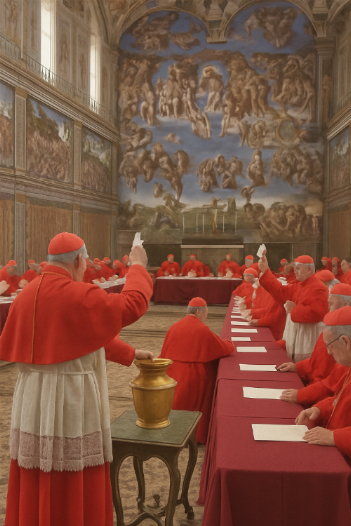The Conclave: History, Meaning, and Rituals of the Papal Election
The conclave is one of the most solemn and mysterious events of the Catholic Church. Whenever a pope dies or resigns, the cardinals gather in the Vatican to elect his successor. This centuries-old ritual is carried out according to strict traditions, including the famous black or white smoke that signals to the world whether a new pope has been chosen.
In this article, we’ll dive deep into the history of the conclave, its current rules, how the smoke is produced, and the spiritual and symbolic meaning behind each step.
Historical Origins of the Conclave
The word conclave comes from the Latin cum clave, meaning “with a key,” referring to the fact that the cardinals are locked away until they reach an agreement on who will become the next pope. This formal method was introduced in 1274 during the Second Council of Lyon under Pope Gregory X, although closed elections had been used previously in some cases.
The need for this rule arose after the death of Pope Clement IV in 1268, when cardinals took nearly three years to elect a successor. The civil authorities of Viterbo, where the election took place, ended up locking the cardinals in and reducing their food rations to force a decision.
Where the Conclave Is Held
Today, the conclave takes place in the Sistine Chapel, within the Vatican. The voting cardinals (those under the age of 80 at the time the papal seat becomes vacant) stay in the Domus Sanctae Marthae, a Vatican guesthouse, and walk to the Sistine Chapel for voting sessions.
Who Can Vote
Only cardinals under the age of 80 are allowed to vote. The maximum number of electors is 120, though this can occasionally be exceeded. During the conclave, the cardinals are completely cut off from the outside world: no phones, internet, newspapers, or communication with family.
How the Conclave Works
The conclave unfolds in several key phases:
-
Entering the Sistine Chapel – The cardinals process in while chanting the Litany of Saints. Inside, they take an oath of secrecy.
-
Extra omnes! – The Latin phrase “Everyone out!” is declared, and the chapel doors are sealed.
-
Voting – The cardinals vote by writing names on paper ballots, which are folded and placed into an urn. Up to four votes are held per day: two in the morning and two in the afternoon.
-
Vote Count – A candidate must receive a two-thirds majority to be elected pope. If no one meets the threshold, the process continues with further ballots.
The Smoke Signals: Black or White?
Black Smoke
After each round of voting, the ballots are burned. If no pope has been elected, chemicals are added to produce black smoke, which pours from a chimney above the Sistine Chapel. This tells the world: No new pope yet.
White Smoke
Once the required majority is reached and the chosen cardinal accepts the role, the ballots are burned without chemicals, producing white smoke, the joyful sign that a new pope has been elected.
To avoid confusion, the bells of St. Peter’s Basilica also ring when white smoke appears.
The “Habemus Papam”
After the white smoke, the dean of the College of Cardinals asks the new pope-elect: “Do you accept your canonical election as Supreme Pontiff?” If he agrees, he chooses his papal name.
Soon after, the Cardinal Protodeacon appears on the balcony of St. Peter’s Basilica and announces the famous words:
"Annuntio vobis gaudium magnum: Habemus Papam!"
“I announce to you a great joy: We have a Pope!”
The new pope then appears and gives his first Urbi et Orbi blessing to the world.
The Conclave as a Spiritual Event
The conclave is not just a political or procedural vote. It is a time of intense prayer and spiritual discernment. Cardinals are expected to vote in good conscience, seeking the man they believe is best suited to lead the Church, under the guidance of the Holy Spirit.
Famous Conclaves in History
-
1978 Conclave – After the sudden death of Pope John Paul I, Cardinal Karol Wojtyła was elected as John Paul II, the first non-Italian pope in over 400 years.
-
2005 Conclave – Following the death of John Paul II, Cardinal Joseph Ratzinger was elected as Pope Benedict XVI.
-
2013 Conclave – After Benedict XVI’s historic resignation, Cardinal Jorge Mario Bergoglio became Pope Francis, the first Jesuit and first South American pope.
Fun Facts About the Conclave
-
In the past, cardinals were sometimes watched by armed guards to prevent outside interference.
-
Some conclaves have lasted months, while others just days. The 2013 conclave lasted only two days.
-
No note-taking or recording is allowed during the conclave. Secrecy is absolute.
Reforms by John Paul II and Benedict XVI
John Paul II established detailed conclave rules in his apostolic constitution Universi Dominici Gregis (1996). Benedict XVI made adjustments in 2007 and again in 2013, reinstating the requirement for a two-thirds majority no matter how long the conclave goes, to avoid elections by simple majority.
The World Waits
The whole world watches for the smoke rising above the Sistine Chapel. Thousands of faithful gather in St. Peter’s Square, and media outlets broadcast the event live. The conclave, though ancient, continues to hold immense significance in both religious and geopolitical terms.
